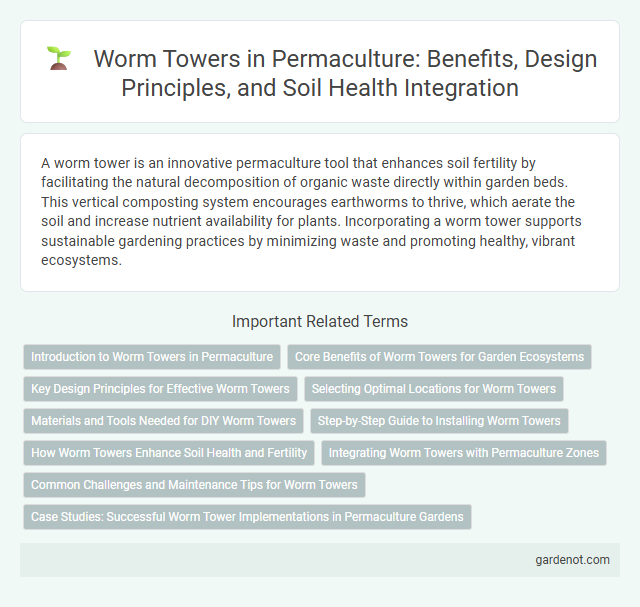A worm tower is an innovative permaculture tool that enhances soil fertility by facilitating the natural decomposition of organic waste directly within garden beds. This vertical composting system encourages earthworms to thrive, which aerate the soil and increase nutrient availability for plants. Incorporating a worm tower supports sustainable gardening practices by minimizing waste and promoting healthy, vibrant ecosystems.
Introduction to Worm Towers in Permaculture
Worm towers in permaculture are vertical composting systems that harness the natural breakdown of organic waste by worms directly within garden beds. These structures promote nutrient cycling by allowing worms to convert kitchen scraps into rich vermicompost, enhancing soil fertility and plant health. Integrating worm towers improves soil aeration and moisture retention, supporting sustainable and regenerative gardening practices.
Core Benefits of Worm Towers for Garden Ecosystems
Worm towers enhance garden ecosystems by accelerating organic matter decomposition, enriching soil fertility with nutrient-rich worm castings, and improving aeration through worm burrowing. These vertical composting systems support beneficial microbial activity and assist in maintaining consistent moisture levels, promoting healthier plant roots. Integrating worm towers reduces garden waste and fosters a self-sustaining, resilient ecosystem.
Key Design Principles for Effective Worm Towers
Worm towers maximize soil fertility and waste decomposition by ensuring proper aeration, drainage, and access for worms to organic waste. Key design principles include using breathable materials like perforated pipes or mesh to maintain oxygen flow, positioning the tower vertically to facilitate worm movement and nutrient distribution, and incorporating holes or slots to allow worms to enter surrounding soil. Strategic placement near plant roots enhances nutrient uptake, promoting sustainable garden ecosystems.
Selecting Optimal Locations for Worm Towers
Selecting optimal locations for worm towers involves choosing well-drained, nutrient-rich soil areas that support consistent moisture without waterlogging. Positioning worm towers near garden beds or fruit trees enhances nutrient distribution and plant growth through efficient vermicomposting. Ideal placement also includes partial shade to maintain temperature balance, ensuring worm activity and health throughout seasonal changes.
Materials and Tools Needed for DIY Worm Towers
Constructing a DIY worm tower requires porous materials such as untreated wood, mesh wire, and breathable fabric to ensure proper aeration and moisture retention. Essential tools include a drill with a hole saw bit for creating ventilation openings, a saw for cutting wood to size, and gloves for safe handling. Adding layers of cardboard or coconut coir inside the tower promotes a healthy environment for worms, supporting efficient organic waste decomposition in permaculture gardens.
Step-by-Step Guide to Installing Worm Towers
Installing a worm tower begins with selecting a well-drained location within your garden bed where organic waste is frequently disposed. Dig a cylindrical hole approximately 18-24 inches deep and insert a perforated pipe or a sturdy plastic tube with ventilation holes to allow air and moisture flow. Fill the tower with food scraps and occasionally add bedding materials like shredded leaves or cardboard to maintain a healthy worm habitat that enriches the surrounding soil with nutrient-rich castings.
How Worm Towers Enhance Soil Health and Fertility
Worm towers improve soil health and fertility by introducing a direct channel for earthworms to access organic waste, which they break down into nutrient-rich castings that enhance soil structure and nutrient availability. These castings increase microbial activity, promote aeration, and improve water retention, all critical for robust plant growth. By continuously recycling organic matter, worm towers create a sustainable cycle of nutrient enrichment that boosts overall garden productivity.
Integrating Worm Towers with Permaculture Zones
Worm towers serve as a valuable tool in permaculture by enhancing soil fertility and nutrient cycling within designated zones, especially in Zone 1 and Zone 2 where frequent access is crucial. Integrating worm towers near vegetable beds or fruit trees accelerates organic matter breakdown, promoting healthier plant growth and maximizing yield from fertility zones. Strategic placement within permaculture zones optimizes microclimate benefits and ensures sustainable, efficient composting directly in the root zone.
Common Challenges and Maintenance Tips for Worm Towers
Worm towers often face challenges such as clogging from compacted organic matter, improper moisture levels, and pest intrusion, which can hinder worm activity and decomposition efficiency. Regular maintenance includes monitoring moisture to keep the environment damp but not waterlogged, periodically adding chopped kitchen scraps to prevent compaction, and covering the tower to deter fruit flies and ants. Ensuring proper airflow and rotating organic material also supports healthy worm populations and maximizes nutrient cycling in permaculture systems.
Case Studies: Successful Worm Tower Implementations in Permaculture Gardens
Case studies of successful worm tower implementations in permaculture gardens highlight increased soil fertility and enhanced plant growth through continuous organic matter decomposition. Gardens utilizing worm towers report up to 40% improvement in nutrient cycling efficiency and significant reduction in waste accumulation. These systems integrate seamlessly with companion planting and water management strategies, resulting in sustainable, self-regulating ecosystems.
Worm tower Infographic

 gardenot.com
gardenot.com